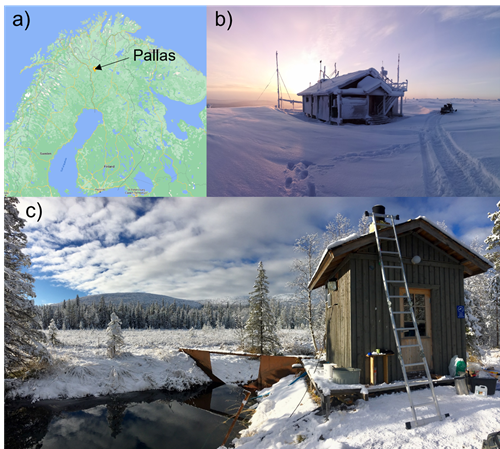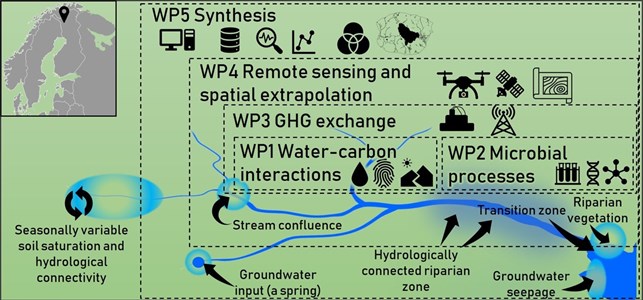
Figure 1. a) Location of the Pallas Research catchment in N Finland, b) FMI Atmospheric mountain-top air chemistry lab at Sammaltunturi, where continuous water vapor isotope measurements for moisture source tracing are collected and c) the stream monitoring hut for continuous water isotope, DOC, temperature, and nutrient trait measurements.
Understand the nuances of Arctic interactions and their climate and ecosystem feedbacks are necessary today now more than ever; as northern regions are experiencing extreme warming, deeper soil thaw, and precipitation changes. This multidisciplinary research consortium will combine decades of Arctic and Boreal research experience and methods of hydrology, isotope geochemistry, microbial ecology, GHG exchanges, and remote sensing in a unique holistic manner to address these paramount issues of today (Figure 2). The overarching objective of the ACWI project is to determine how unique water sources liberate and transport C of different ages and liabilities and the extent to which this coupling of water and C sources drive the harmonics of stream and lake microbial C processing and GHG emissions.

Figure 2. Overview framework for the AWCI program of research with 5 work packages (WP) that span a range of measurements and scopes of work across scales from microbial interactions with hydrologic and biogeochemical processes to remote sensing and regional scale extrapolation. Diagram designed by Dr. Jussi Jyväsjärvi.
The research consortium includes members from the Finnish Meteorological Institute (Associate Professor Annalea Lohila and Drs. Sari Juutinen and Mika Aurela ) and colleagues from the University of Helsinki, Professor Tarmo Virtanen. UOulu collaborations with FMI at Pallas research station were initiated in earnest with Welker’s original AoF award in 2018; this new ACWI project will deepen and expand these collaborations into a new suite of studies with new collaborators, colleagues and students in Finland and beyond.
This multidisciplinary research group will be addressing several issues that are cornerstones of the changing Arctic and Boreal systems today (Figure 2): including: a) microbial biodiversity and biogeochemical interactions; b) freshwater resources-weather-climate interactions, c) forest and landscape C source-sink balances and C neutrality, and d) the role of ancient C in tundra and aquatic trace gas emissions, stream and lake food webs. These multidisciplinary process-level observations will be scaled to regional patterns using remote sensing and will also further be used in earth science models. The team will use year-long measurements of C sources, ages (i.e. 14C – radiocarbon measurements) and quality paired with stable water isotopes (18O & 2H), that will delineate patterns of surface water connectivity to the adjoining riparian and forested uplands. These studies are not being undertaken is isolation but place our Pallas program within a network of catchment and watershed studies that address ACWI in a suite of locations: including Krycklan and Abisko Sweden, Oulanka Finland and at Toolik Lake, Alaska.
